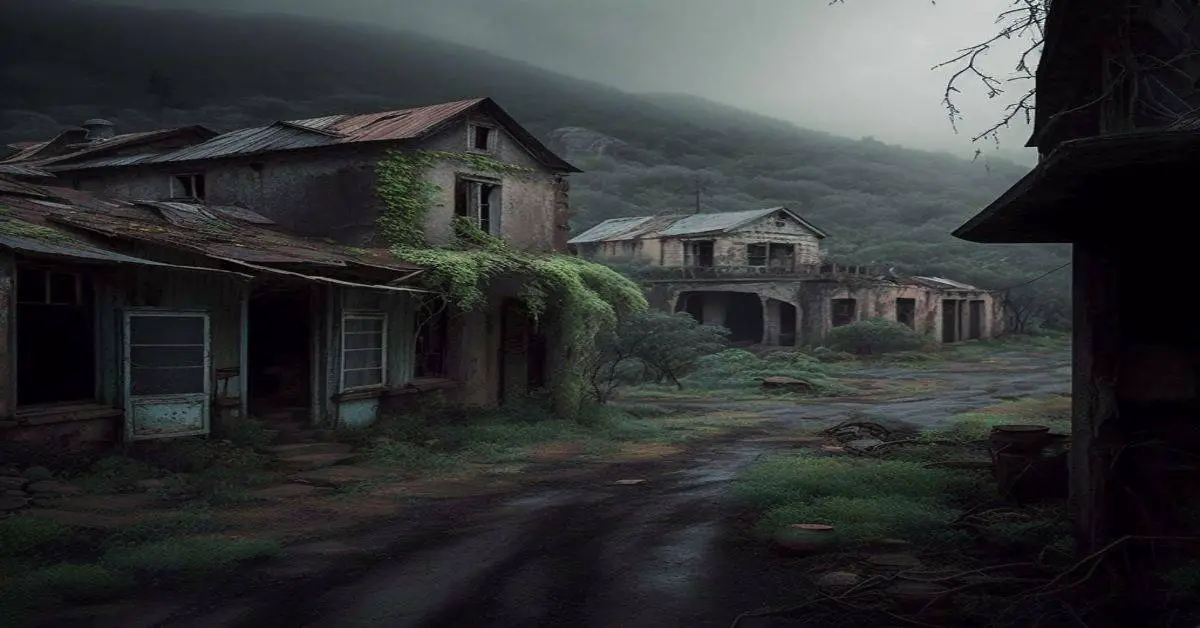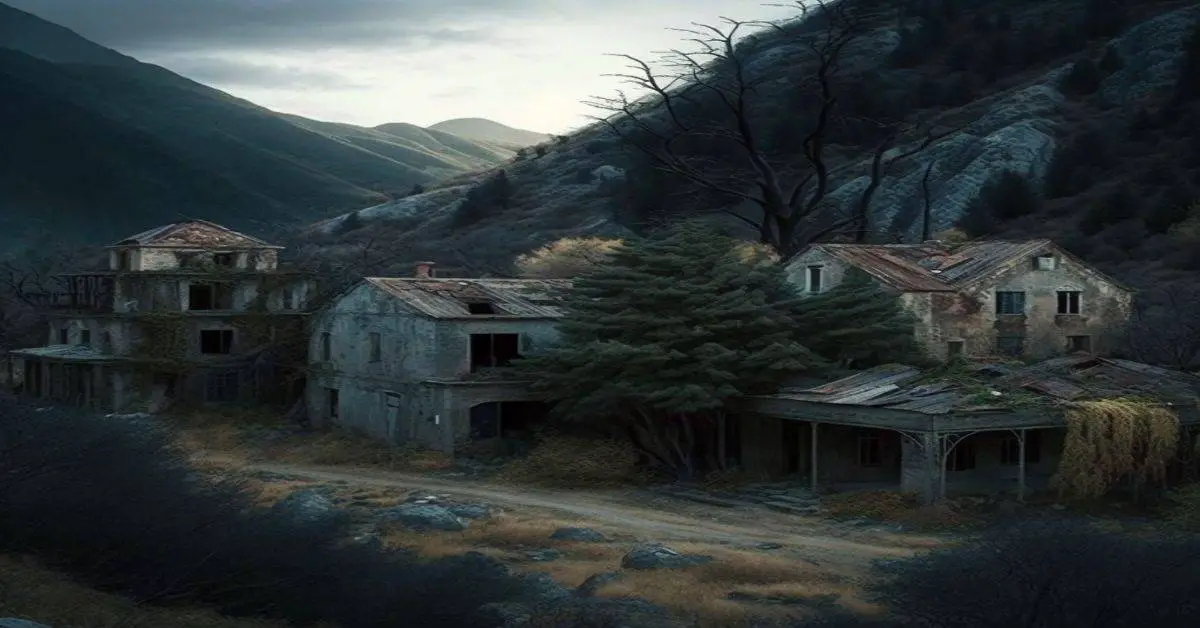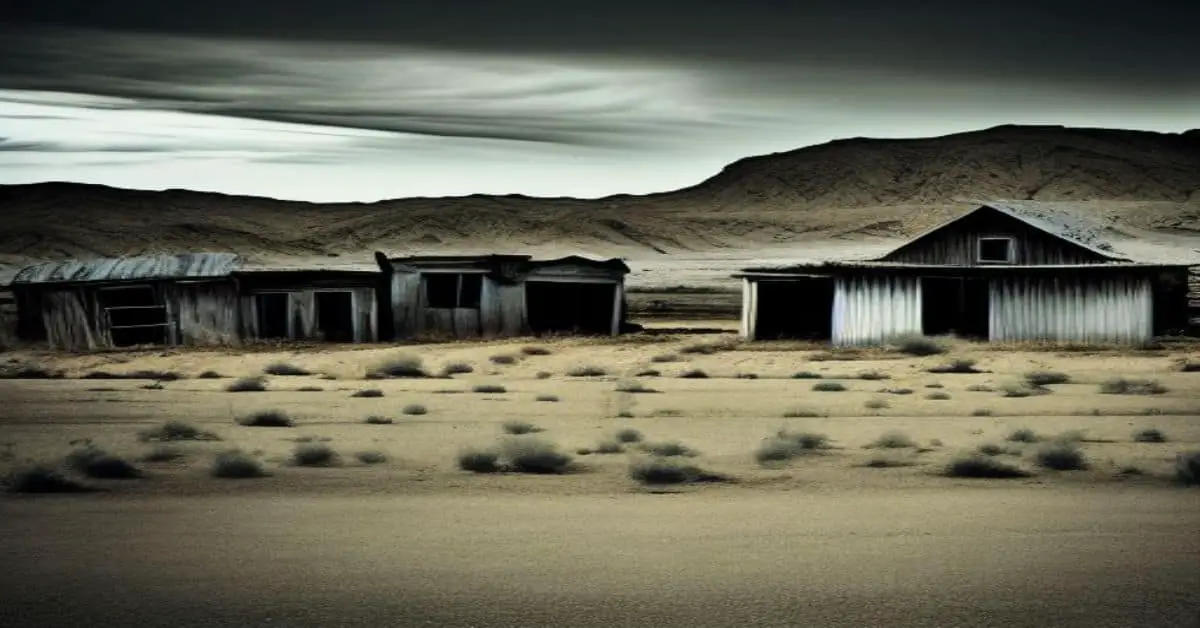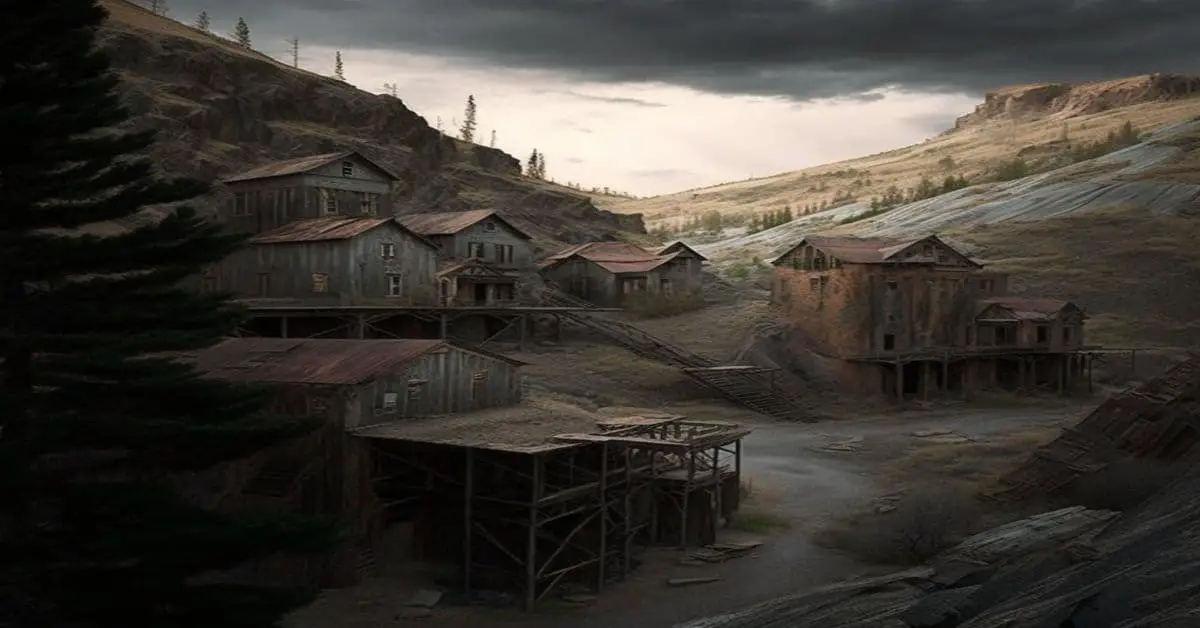Ken Norman’s Old Mansion – Homewood, Illinois
A once-glorious mansion was now abandoned and left to crumble.
This abandoned building isn’t in the middle of nowhere. It’s actually located between a pharmacy and a golf course. The mansion used to belong to former NBA player Ken Norman when he played for the Los Angeles Clippers.
The mansion had all the fancy features you could imagine, like an indoor pool and a basketball court. The builders even constructed the new mansion around the old house that was already on the property, so the old fireplace still stands in the center of the mansion today.
But now, the mansion is just a shadow of its former self. It sits empty along a public road, and nature has started to take over. The interior is covered in grime and mold, and the paint is peeling off the walls. The game room, where the indoor pool used to be, is now just filled with debris.
Note: The mansion was sold in 2019 and has since been demolished. Do not enter the property, as it’s considered trespassing.
The Abandoned Town of Cairo, Illinois
A once-bustling port town that is now mostly deserted.
Cairo, located at the confluence of the Mississippi and Ohio rivers, was a thriving town thanks to the steamboat industry. When railroads became popular, Cairo was also a major train stopping point.
But now, walking or driving through Cairo is like a trip through a ghost town. The once-busy downtown area is now filled with crumbling buildings and boarded-up windows. The town has declined for decades, with businesses closing and residents leaving.
The town’s decline is due to a combination of factors, including economic desperation, racial tensions, and periodic flooding. The Civil War Reconstruction period brought formerly enslaved people to Cairo, and racial tensions remained high in the community.
In the mid-1960s, a police murder of a young Black soldier prompted protests and riots, and a white militia group was formed in response. The racial unrest and economic struggles continued, leading to the town’s population declining from over 15,000 in the 1920s to just 2,000 in 2010.
Although the local government has tried to revive the city through historic preservation initiatives, most have failed. The only surviving cultural institutions are a few state-owned Victorian manors and the Cairo Public Library. The rest of the town remains abandoned.
Note: To get to Cairo, use Route 51, and you’ll drive right through the town. There are bridges to the northwest, south, and east.
Damen Silos – Chicago, Illinois
Abandoned grain silos and tunnels in Chicago make for an exciting urban adventure!
Once a busy hub of grain elevators, these structures are now left empty and waiting for thrill-seekers, urban explorers, and graffiti artists. In 1977, a factory explosion made the site unusable, but the tunnels were never sealed.
These dark passages take you inside the giant silo bases, where ropes lead up to ladders that reach the top. From there, you can see the Chicago skyline in a unique way, but be warned – it’s not safe to climb.
You can explore the tunnels and lower levels for an exciting day trip, even if you’re new to urban exploration. On most of the sites, you’ll find beautiful graffiti art and feel safe as you wander through the rows of color.
Before you go, keep in mind that there’s a sign that says “State Property, No Trespassing,” and you should explore at your own risk. You can drive to the site on S Damen Ave or get there by foot or bike from the Canalport Riverwalk.
Zion Evangelical Lutheran ‘Ghost Church’ – Chicago, Illinois
Discover a one-of-a-kind abandoned church in Chicago’s Pilsen neighborhood.
In the late 1800s, the Lower West Side of Chicago was home to many German and Irish immigrants working long hours doing manual labor. On one day off a week, they would find solace at their local church and enjoy a cold beer.
The Zion Evangelical Lutheran Church was built in 1880 to serve the community and has a 90-foot bell tower, wooden doors, Chicago brick, and Gothic German script above the entrance. Over time, German residents moved out of the Pilsen neighborhood, and by 1956, the church was abandoned. A fire in 1979 destroyed the roof and interior, and a windstorm in 1998 knocked down many of the walls.
The owner, John Podmajersky Jr., planned to demolish the building. Still, when descendants of the church’s early congregants visited after hearing about the windstorm, they brought a record of the church’s history, and Podmajersky was moved to save the remains.
Today, the bell tower has a modern skylight, the walls are restored and stabilized, and the inside of the church is now a peaceful garden sanctuary. A badly burned crucifix hangs inside, protected by a clear plastic shield.
Podmajersky hasn’t turned the tower space into artist studios yet, but the church remains a fascinating piece of Pilsen’s forgotten history.
Prairie Observatory – Oakland, Illinois
An old observatory in the middle of the Illinois prairie. It’s where scientists used to look at the stars, but today it’s empty and full of graffiti. It might look like a movie set for a post-apocalyptic film!
You can get to the observatory from a parking lot or on a Walnut Point State Park trail. But be careful! The trail can be tough to walk on, and getting inside the building is prohibited. It’s best to admire it from a safe distance.
Chicago Freight Tunnels – Chicago, Illinois
Under Chicago’s downtown area, a 100-year-old network of tunnels used to transport coal and ashes. They were busy from 1904 to 1959, but people forgot about them until a flood reminded everyone they were there.
The Illinois Telephone and Telegraph Company built the tunnels and later became the Chicago Tunnel Company. They were so confident in the work that they built 60 miles of tunnels before getting their first customer! Once the network was finished, they offered services like telephone and telegraph connections, coal and merchandise deliveries, and even “tunnel air” (55°F year-round) for natural air conditioning in theaters and hotels.
Small electric trains used the tunnels to make deliveries and avoid surface traffic. Train operators used street names painted on the walls to navigate and avoid crashes with a “sight and sound system.” The tunnels were most popular in the 1940s and 1950s, but they lost business to trucking companies and the Chicago Tunnel
Hello Peoria Building – Peoria, Illinois
This abandoned building in Peoria, Illinois, has recently been taken over by artists. You’ll find tiny treasures, big murals, and odd sculptures all over the windows and doors.
The building is seven different buildings joined together. It has lots of fun windows and doors that artists have used as inspiration for their works. You can explore the nooks and crannies of the building to find little treasures made by local artists. Don’t miss the hand-painted wooden spools hiding in different spots or the painted sidewalk squares that make the area look like a giant board game!
You’ll see benches and sculptures made from tree branches, scrap lumber, and garden hose in the parking lot. New, colorful artwork always seems to pop up in this unique place, surrounded by industry.
Know Before You Go
- Parking is free
- Watch your step! There might be broken glass and woodchucks that dig holes in the building.
Bachelor’s Grove Cemetery – Midlothian, Illinois
This small, abandoned cemetery is a hot spot for ghost hunters.
Bachelor’s Grove Cemetery was part of a small settlement established by four single men. The cemetery was abandoned around the turn of the century and has since been damaged and disturbed, despite the growing number of ghost stories and myths about the place.
The cemetery has 82 plots and was established in 1840 for the residents of a small, short-lived Illinois settlement. Russian rail workers also used it. By the 1920s, rumors spread that gangland bodies had been dumped on the grounds.
By the 1950s, the cemetery was no longer in use, but it was a popular hangout spot for teens who would break the headstones or steal them. So many pieces of the cemetery ended up in police stations that most surrounding stations had some.
The cemetery became known for its ghost stories, with sightings of a white lady, a black dog, and floating orbs being reported. A semi-serious study of the site was even conducted.
In 2014, the Forest Preserve cleaned up the cemetery, repaired the fence, and started maintaining it. A landscaping service mows the grounds, cleans up branches, and removes garbage.
Know Before You Go
- To get to Bachelor’s Grove Cemetery, look for the Rubio Woods Forest Preserve entrance on 143rd Street, just east of Ridgeland Avenue.
- You’ll find the entrance to the path leading to the cemetery across the street from the preserve. It’s about 100 feet west of two cell phone towers.
- Park at the Rubio Woods Forest Preserve across the street.
Update (Nov 2020)
- Many of the headstones have been damaged or removed.
Cahokia Mounds – Collinsville, Illinois
Cahokia was once a city with a big history. It was a place for worship, trade, and even human sacrifices. It was once one of the largest cities in the world, bigger than London.
Cahokia was near St. Louis and had around 120 mounds used for different things. One of these mounds, Monks Mound, was nearly 100 feet tall and is the biggest earthwork from ancient times in North America.
Cahokia was a center for religion and culture for around 20,000 people. It was first settled around 600 AD, and people started building mounds about 300 years later. The city was used until the early 15th century, but no one knows why it was eventually abandoned. Some think it was because of war, invasion, problems with not having enough food, or deforestation.
A monument marked the equinox and solstice in the city, like Stonehenge in England. Archaeologists found the remains of this monument, and now there is a replica.
Cahokia Mounds State Historic Site is now a UNESCO World Heritage Site. It is just 8 miles from St. Louis, and you can visit it in Collinsville, Illinois. The center is closed on Mondays and Tuesdays, but they have yearly digs where you can come and work for a few weeks.
Lawndale Theater – Chicago, Illinois
The Lawndale Theater is now abandoned on Roosevelt Road.
The theater opened in 1927 and showed British silent films and had vaudeville performances, boxing nights on Tuesdays and Wednesdays, and Chorus Girl Contests on Fridays. In the mid-1930s, the theater was bought by the mob. It was used as a theater and sometimes rented out for other events.
During World War II, the neighborhood changed and became mostly African-American. The Lawndale had different owners and eventually became the Rena Theatre in 1949. It showed movies during the week, and music shows on the weekends.
In 1961, a gang leader was reportedly shot dead in the main staircase, and the theater closed. In 1964, it became a church and was used as one for 40 years until it closed in the early 2000s.
Now the theater sits abandoned on Roosevelt Road, once majestic in its beauty, in decay.
Joliet Iron and Steel Works (Joliet Iron Works Park) – Joliet, Illinois
Once a big steel mill, it’s a park with ruins to explore!
The Joliet Iron and Steel Works was once one of the biggest steel mills in the US. It made 2,000 tons of iron every day! But now it’s just a cool place to see ruins.
The factory started in 1869 and was huge for its time. People in Joliet were very good at finding stones and metals, so the steel mill was important for their success. The mill had four big blast furnaces and employed a lot of people. But the factory had to close in 1936 and again in the 1980s because it wasn’t making enough money.
The site was left to fall apart for almost ten years, but then the county forest district took over. Instead of tearing down the ruins, they kept them and made it a park for people to hike.
The original buildings are gone, but the foundations and other structures remain. Visitors can walk around the park and read signs to learn about the mill’s history. In 2013, some underground areas had to be filled in because they were unstable.
Know Before You Go
The park is off Columbia Street near Hwy. 53, near the DesPlaines river. There is free parking and restrooms.
Armour Meatpacking Plant – East St. Louis, Illinois
An old meatpacking plant is now a place for adventure!
The Armour Meatpacking Plant was once huge. It was second in size only to another plant in the Chicago stockyards. The plant employed over 4,500 people and was a popular tourist destination for tours of the slaughterhouse and processing lines.
But then the meat industry changed, and Armour moved to a different location in the Midwest. The National City plant closed in 1959 and was given to the city of East St. Louis, but it has been abandoned and falling apart.
Now, the buildings have fallen or are just empty shells. But this has made it a great place for urban explorers to visit. Walking through the ruins is creepy and cool.
But be careful! The main building is about half demolished, and construction equipment is visible. The Missouri and Illinois Departments of Transportation have plans to build a highway near the old plant, which might be why it’s being demolished. So, be sure to see it before it’s gone for good.
Update 2016: Sadly, this amazing facility was completely demolished and razed in 2016 and no longer exists.
Know Before You Go
This is where the plant used to be:
- From St. Louis:
- Take I-70, I-40, or I-44 and follow signs for I-55 North, crossing the river.
- Keep right and stay on I-64 East/Illinois 3.
- Follow signs for Louisville/St. Clair Avenue.
- Take Exit 4, Illinois 3.
- Merge onto St. Clair Ave.
- Stay on St. Clair past the traffic circle.
- Turn right on North 1st Street.
- Take the first left onto Exchange Avenue.
Ebenezer Floppen Slopper’s Water Slides – Villa Park, Illinois
Do you like adventures? There’s a cool place in Illinois that will give you a new kind of adventure.
At first, it just looks like a big overgrown hill. But if you look closer, you’ll see an abandoned water park. It’s called Ebenezer Floppen Slopper’s Water Slides, on Route 83 in Oakbrook Terrace, Illinois.
The water park opened in 1980 with only two simple water slides. But it became so popular that they added more slides and attractions. Some slides were meant to be ridden with friends on rubber mats; others were for sliding headfirst or on an inner tube. They used soft material on the slides so people wouldn’t get hurt. In 1987, they even added bumps to the bottom of the concrete slides to create “Doc River’s Roaring Rapids.”
But then, in 1989, the park suddenly closed. No one knows why. Over time, it became overgrown and creepy. Some slides have graffiti on them, and animals and insects have made it their home. Did you know that the area was a landfill before the water park?
It was called “Mt. Trashmore,” and it was a place for non-toxic waste. In the late 1970s, Mark Collor saw the hill and had the idea to turn it into a water park. The water slides aren’t working, but the overgrown area is still fun.
Know Before You Go
The entrance used to be on Riordan Road, but now there’s a big fence blocking it. There might be security cameras and motion detectors, so be careful.
Abandoned Brach’s Candy Factory – Chicago, Illinois
Do you like sweets? There was a huge candy factory in Chicago that made lots of treats. But now it’s just an abandoned building.
The factory was built by the Brach’s candy company in 1923. They spent a lot of money, $5 million, to make it the biggest candy factory in the country. They made over 250 kinds of candy. But the cost of sugar went up and up, and by the early 2000s, the factory had to close.
Since then, the factory has been falling apart because no one has cared for it. Part of it was used in a movie called The Dark Knight, but the rest still stands. There are plans to tear it down, but it’s a reminder of a sweeter time in Chicago.
Nike Park – Addison, Illinois
Once a Cold War missile launch site, this park is now a public park in Addison, Illinois.
During the Cold War, the American government built many missile launch sites. But now, one of them has become Nike Park. It used to be part of a larger Nike Missile complex, but now it’s a park for everyone to enjoy. Unfortunately, the missile launch site is gone, but the radar and control tower remains. You can find them in Nike Park, surrounded by baseball fields, tennis courts, and a playground.
While all the weapons are gone, there’s a decommissioned missile on display in Villa Park, near the local VFW hall.
Know Before You Go Finding Nike Park can be tricky. The park entrance is on the east side of Rohling Rd between two businesses, with just a small sign. You can park on S. Grace St. opposite 475 S. Grace St. or W. Fullerton Ave.
Abandoned Illinois Soldiers’ and Sailors’ Children’s School – Normal, Illinois
This 19th-century abandoned orphanage used to be a boarding school for the children of Civil War veterans.
Opened in 1865 as the Civil War Orphans’ Home, the school was a place for children of veterans. Later on, other war orphans and all orphans were accepted. From 1916 to the 1960s, Illinois State Normal University (now Illinois State University) ran the school. After the closure of the ISSCS in 1979, some buildings were demolished, and others were renovated into homes or businesses. The main school building still stands on Beech Street, abandoned.
Going inside the building is not legal, but many people still do. There have been reports of aggressive dogs and homeless people inside. And because of its creepy look, rumors say that the area is haunted by the ghosts of children who died at the school. There was a small cemetery for children who died at the school, but it was moved to a cemetery in Bloomington in the 1940s.
Update: Demolition on the building began in July 2017.
The 606 – Chicago’s Park and Trail System
Have you heard of The 606 in Chicago, Illinois? It’s a unique park and trail system created from an old, abandoned elevated railway.
The Beginning
In the 1990s, the Bloomingdale Line train slowed down, and people started thinking about how the train line could be used to add more green space. The City of Chicago asked residents for their opinions and discovered that the Logan Square neighborhood needed more open space. To help, the city proposed turning the Bloomingdale Line into a park, which was included in the 2004 Logan Square Open Space Plan.
A Community Effort
A group of neighbors formed Friends of the Bloomingdale Trail to help make the park a reality. They got support from the community and even the Trust for Public Land, a national non-profit organization that helps create urban parks. They held meetings to gather ideas for the park’s design and features. Finally, in 2013, they unveiled the final plans and named it The 606.
The Park Today
The 606 is now a special park that has something for everyone. It has art, history, trails for walking, biking, and running, event spaces, green spaces, and more. It’s a public-private partnership between the City of Chicago, the Chicago Park District, and the Trust for Public Land.
The park connects four neighborhoods in Chicago and is a signature project of Mayor Emanuel’s plan to create 800 new parks, recreation areas, and green spaces in the city.
Things to Know Before You Visit
The 606 runs for 2.7 miles between Ashland and Ridgeway, with 12 access points about every quarter-mile. You can walk, bike, or take public transportation to get there. There’s no dedicated parking, but you can find street parking in the neighborhoods near the trail. If you’re not walking or biking, we recommend taking the CTA Blue Line to get to the park.
A Unique Hiking Experience
The 606 is in the Bucktown/Wicker Park area of Chicago and is a cool place for a hike. The trail is three miles long and is elevated, giving you a different view of the city. During the day, it’s a peaceful place to enjoy the sights, but at night, it can be a little noisy because local teenagers like to go there to drink. We recommend hiking during the day and being careful of the broken glass left behind.
That’s the story of The 606 in Chicago! We hope you have a chance to visit this special park and trail system soon.



